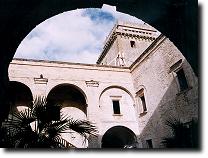 City of Leporano
City of LeporanoRecent archaeological excavations between Saturo and Gandoli, have brought forward proofs defining the presence of the Neolithic civilization. The excavations have shown two aspects of typical stratification of the stone age: the beaten floor and the flat structural stones. The discovery of a sub-circular shaped tomb together with pieces of broken vases, flint stones and other burial objects testifies the high level, for the time, of the primitive way of life in the land of Leporano. Leporano: underground treasure which comes to light to explain man's history.
The great "Magna Grecia"
The history of Saturo is strictly bound to the origins of Taranto. The two existing versions about the orriginis of Taras
are both cennected with Saturo. Antiochus of Syracuse says that Phalanto, the head of the Parteni, was allowed to live Satyrion and the fertile Ionian area
by the Delphian oracle.
The second version (perhas the moste credited one) says that the word "Satyrion" comes from Satyria, the local nymph loved by Poseidon,
god of the sea. Taras, the founder of Taranto, was born from their love. Both versions suggest us the priority of Saturo over
Taranto: the most important centre in the great Magna Grecia.
The Roman age
On the promontory between Porto Saturo and Porto Pirrone there are the rests of the Roman Villa which evokes history.
The numerous Roman villas we have reference of, Leporano possesses the rests of the sole model in the province.
The area is now under protection of the Fine Arts Commission.
Qeing to the plan of the villa, its axial position, the piscina and the long "ambularco", we can compare our villa
with the famous ones of Sirmione, Mysteries in Pompei and Papyri about Herculaneum.
Household pottery, oil lamps from Africa, polycrome marbles and a bronze coin found under a red and white mosaic
floor chess-board shaped, testifly the villa dates back to the Imperial age.
It is divided into two parts. In the first part there were the residential rooms, in the second part there were the baths.
To the north-west there were also some rooms for the servants and a large cistern. Leporano: an holiday resort still
in the Imperial Rome.
The Roman Acqueduct
The "Pozzo di Lama Traversa", an underground lake placed between Leporano and Saturo, was, together with other spring
water wells, the territory water supply. It is sure that a reticular Roman aqueduct utilized the water of Lama Traversa
to furnish the whole city of Taranto.
The natural treasure of the underground water, thanks to the still existing spring water wells, has been filling the
ear, the bunch of inebriating nectar and blossoming trees since ever in a poetic spring refulgence.
 The Muscettola Caste
The Muscettola Caste
Square shaped with a large court inside, the Muscettola Castle is located on the highest point in the historical centre.
From there it dominates the landscape and, at the same time, characterizes it.
The Municipal administration bought it in 1980 from the last heirs Motolese-Lazzaro. Perhaps its building dates back to
XV century, but the presence of a square tower and some stone masonry leave us uncertain about the exact building date.
Throughout the centuries, as the landlords changed, the Castle underwent innovations and alterations according to the
use which it was everytime destined to.
The Castle, the feudal overlods' holiday place, has been used for meetings, amusements and festivities. Now it is being restored.
It is likely that the Castle will be converted into an archaeological museum and different study centres.
The Town Walls and the Gates
Besides a few remains, it is still possible to admire two of the three original gates of Leporano walls. The first, throught which we enter
the historical centre coming from Talsano-Taranto, preserves its a ancient charm even if it has recently been restaured.
The second, dating back to 1653 and located to south-west of the town, is of different style.
It is said that round it the feudal overlods administered justice.
The coastal guard Tower
As privacy has always been a danger for the coastal people, they were obliged to defend themselves from the continual attacks.
During the Viceroy's reign and starting from 1560, a complex system of defence, made of 21 towers displaced from Taranto to Punta Presuti, was developed.
Of the original 21 towers only 14 can be still sees.
One of these is the Guard tower of Saturo located on the promontory between Porto Saturo and Porto Pirrone, just about the Roman Villa.
Square shaped, the building develops on two levels.
A further masonry structure has been added on the roof at the beginning of the century.
The majestic tower has no static problems. Perhaps it will be used for tourist purpose in the near future.
The archaeological Park
The land of Leporano, between Saturo and Gandoli,which overlooks the green sea, is rich in archaeological invaluable finds
of the Classic era. To hand down such natural resources, a plan is being studied to realize an archaeological park for the
preservation of the discovered material.

| Info about the city of Leporano |
|---|
|
General information... Gastronomy and amusements... Strutture ricettive... |
| Info provincia di Taranto |
|---|
|
Informazioni generali... Arte... Strutture ricettive... |
| Info regione Puglia |
|---|
|
Informazioni generali... Arte... Clima... Strutture ricettive... |
| Search for Receptive Structures in Apulia |
|---|
| The useful search engine to find lodgings and accommodations! |
| Tell to your friends! | ||
|---|---|---|
| Recommend this page to your friends: click here! | ||

